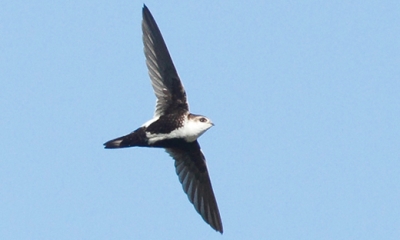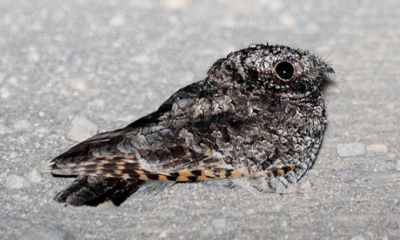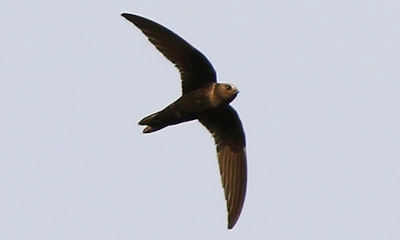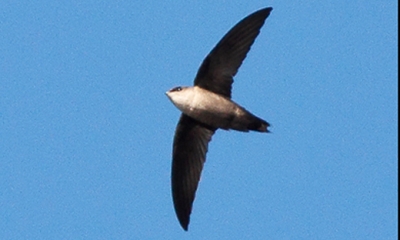
Nighthawks and Swifts
Nighthawks and swifts are nocturnal insectivores.

Types of Nighthawks and Swifts

High overhead at the top of the rimrock in Oregon's desert country, the White-throated swift swoops, soars, and darts about erratically, hunting and catching insects. At great speed, it disappears into a crevice on a cliff without appearing to slow down. Its long, strong claws enable it to crawl deep inside these crevices to roosting and nesting areas, which often cannot be seen from the entrance.
This bird is a locally common to abundant breeder, primarily on eastern Oregon cliffs. It is an occasional spring and sporadic fall migrant in western Oregon along the coast, in the Willamette Valley, and on the western slope of the Cascades.
Hear the call of the White-throated swift
Photo by Julio Mulero, Flickr

The Common nighthawk is a migrant to Oregon with one of the longest migration distances of any North American bird. It is also one of the last to arrive in Oregon. Long, slender wings are marked by a white patch on the "hand" visible in flight from great distances. When perched on the ground, the cryptic brown, gray, and black mottling makes the bird almost invisible.
This bird breeds and migrates at all elevations through the state. Its nesting habitat is characterized by open landscapes with little ground cover and is most abundant in sagebrush and rocky scablands and rimrock habitats of eastern Oregon.
The Common nighthawk is an Oregon Conservation Strategy Species in the Columbia Plateau, Klamath Mountains, and Willamette Valley ecoregions.
Hear the call of the Common nighthawk
Photo by Nick Myatt, ODFW

This nocturnal species is seldom-seen, sometimes known by its call on summer evenings or as a blur fluttering quickly up from secondary roads.
Cryptic mottled, brownish-gray plumage helps it to blend in with dry, barren ground and to conceal it from predators. Common poorwills are smaller and shorter-tailed than other nightjars; when observed in the air, their flight resembles a moth or bat, noiseless and low over the ground.
Locally common east of the Cascades, they are rare farther west in Josephine County. They are commonly found along the Snake, Wenaha and lower Grande Ronde rivers.
Hear the call of the Common poorwill
Photo by Dominic Sherony, Flickr

Insects swept up in a rising air mass are favorite prey of this species nicknamed the "cloud swift." It prefers to nest near or even behind the curtain of a waterfall.
This dark swift glides for long distances, often very high in the sky, with its wings held somewhat downward. It is larger and darker than the more common Vaux's swift, and has a slightly forked tail.
The Black swift is a rare to uncommon spring and fall transient and summer visitant throughout the state. It's an Oregon Conservation Strategy Species in the West Cascades ecoregion.
Hear the call of the Black swift
Photo by Amy McAndrews, Flickr

This small swift is best known for its quick flight and dazzling aerial agility, perching only when nesting or roosting. It is aerodynamically designed for fast speeds with long, pointed wings, short stout legs, and a compact body.
The Vaux's swift is a transient and summer resident nesting in older forests and brick chimneys statewide except the southeast part of Oregon.
Hear the call of the Vaux's swift
Photo by Julio Mulero, Flickr

